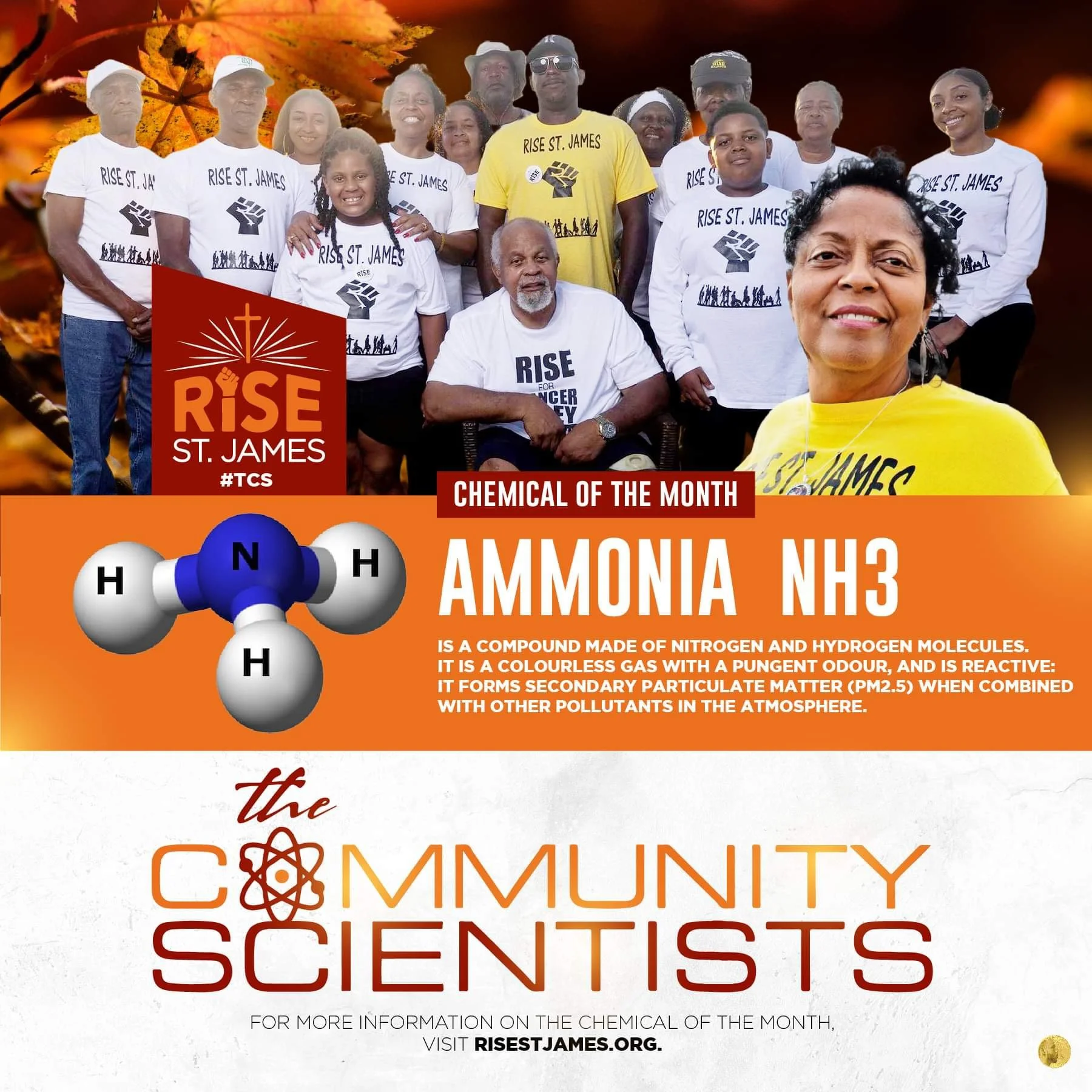CHEMICAL OF THE MONTH - Ammonia
By Caitlion O. Hunter, Esq.
A service program of RISE St. James; Caitlion O. Hunter, Esq.; Tim Schütz, PhD Researcher, Anthropology University of California, Irvine; and The Community Scientist (TCS) Research Team
Ammonia has been in the news lately as a “fuel of the future,” since it is a chemical compound of nitrogen and hydrogen which releases no carbon when burned. However, since most of these proposed ammonia projects will be powered by and produced from fossil fuels, ammonia plants will continue to affect Cancer Alley and other fenceline communities.
Ammonia has a strong, unpleasant odor that can be detected at 5 PPM in ambient air. It is a colorless gas, and is commonly used in window and other household cleaners. Ammonia is also a raw ingredient for many plastics and petrochemicals, and it is a key component of synthetic fertilizers.
Short-term inhalation exposure to high levels of ammonia can cause irritation and serious burns in the mouth, lungs, and eyes. Chronic exposure to airborne ammonia can increase the risk of respiratory irritation, cough, wheezing, tightness in the chest, and impaired lung function. Workers who are exposed to high levels of ammonia on the job have been shown to develop respiratory symptoms and decreased lung function. Additionally, damage to the lungs caused by ammonia can make people more susceptible to bacterial infections in the lungs. Animal studies suggest that ammonia can also affect the liver, kidney, and spleen. Ammonia is extremely toxic to fish when released into waterways.
Ammonia is produced by using large amounts of energy to first separate nitrogen from air, and also hydrogen from natural gas, and then combine the two under high temperature and pressure. This process generates massive amounts of carbon dioxide in the process- on average, a facility emits 2.86 tons of CO2 for every ton of ammonia produced. In fact, ammonia production accounts for 2% of the world’s entire energy consumption, almost always from burning fossil fuels, and direct CO2 emissions from producing ammonia are as large as those of the entire nation of South Africa. “Blue” ammonia projects are often cited as zero-carbon solutions, but use the same fossil gas feedstock. (You can remember that “blue” ammonia means it was made from natural gas because natural gas stoves burn blue). Blue ammonia projects propose to capture only the CO2 emissions (not the other greenhouse gases) from the production facility and transport and inject that waste CO2 deep underground in a process called carbon sequestration (or storage).. As discussed in the previous Chemical of the Month, CCS is an experimental technology that has never been successful at a large scale.
When used industrially, ammonia presents dangers in everyday operations. Ammonia gas is often compressed to a liquid, which requires both intense pressure and using high amounts of energy to maintain a temperature of -27F/-33C. During the record-breaking summer of 2023, the Dyno Nobel plant in Waggaman sought to release four times more ammonia emissions than its permits allowed because its equipment could not keep the ammonia cold enough under pressure. During hurricane events, where plants experience power loss or extinguishing of flares, compressed ammonia can be extremely dangerous as it begins to heat up inside storage tanks. After Hurricane Ida, CF Industries in Donaldsonville released large quantities of ammonia directly into the air without flaring, and the Cornerstone facility (associated with Dyno Nobel) in Waggaman released at least 7000 pounds of ammonia. Even during normal operations, explosions or releases at ammonia plants are not uncommon. On December 1, 2022, Donaldsonville Primary School was evacuated due to an ammonia leak at CF Industries.
The proposed Air Products blue hydrogen and ammonia plant in Ascension Parish says it is a “clean energy complex.” Ammonia is being treated as a zero-carbon solution, but the truth is that fossil fuels are at the very heart of all blue ammonia production. Blue ammonia and blue hydrogen are both dependent on expanding natural gas production, which causes increased methane emissions, and will require a massive buildout of pipelines carrying hazardous carbon dioxide through fenceline and rural communities. Producing ammonia from fossil fuels, then capturing and attempting to store the CO2 emissions, is not a green future.
HOW TO REDUCE THE NEED FOR AMMONIA:
Learn more about regenerative agriculture and crop rotation. Ammonia is used to create synthetic fertilizers, but these ancient forms of fertilizer restore fertility and health to the soil naturally. Start composting at home to create your own fertilizer for gardens and plants.
Purchase household cleaners that are ammonia free.
Attend public meetings for the proposed Air Products hydrogen and ammonia plant to demand only clean, regenerative industry comes to Cancer Alley

